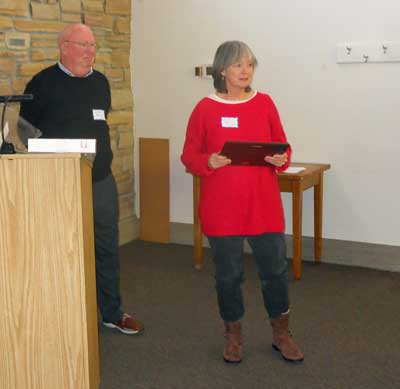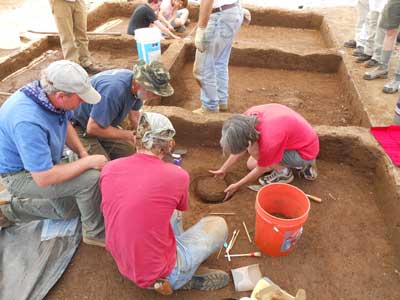

After earning highest honors as an anthropology undergraduate at Tufts University, Maureen went on to pursue a master’s degree in archeology at the University of Wisconsin in Madison where she did paleodietary research on human skeletal material. It’s interesting how the “circle of life” works on multiple levels; in Maureen’s case, human skeletal material represented both an early interest and would come to dominate the last several years of her working life.
Her first 12 years in Maryland were with the Maryland Geological Survey’s Division of Archeology under Tyler Bastian, where she immediately took over the reins of the Monocacy River Research Project, creating the statistical research design, conducting the field work, and writing the report. That report, and the prehistoric predictive settlement model it contains, stands as a classic in Maryland archeology. In addition, she published two journal articles and presented two professional papers on this work, reflecting a sense of responsibility to the profession that characterized her entire career. Her support of the Archeological Society also began during her time at MGS through her work with the Annual Field Sessions in Maryland Archeology where she co-directed with Dennis Curry two Sessions at the Chapel Point site, and three Sessions at the Rosenstock site. She also served as the MGS volunteer coordinator. From this beginning, Maureen established her dedication to the members of the Society, for whom she worked tirelessly over the balance of her career.
While at MGS, Maureen applied her organizational skills to the management of the archeological sites inventory. Recognizing the applicability of computer database systems to this inventory, Maureen computerized the inventory in a time when personal computing was in its infancy, and database software was limited and rapidly evolving. This work led to a growing interest in Geographic Information Systems and ultimately to a Master’s degree in Computer Science from the Johns Hopkins University. Following the move of the research branch of the archeology office from the MGS to the Maryland Historical Trust in 1991, this new skill placed Maureen in a position to develop one of the nation’s first GIS-based site inventories.
At MHT Maureen built and then nourished the GIS-based inventory, developed and elaborated the various sites computerized databases, and grew the GIS program through the successful pursuit of numerous grants. Prior to this work site records were on paper and USGS quad maps, all stuck in cabinets, and with no way to easily search them. The databases Maureen developed are vital for planners and researchers, and represent a sea-change in the way archeologists do their business. While masterfully coordinating this effort with her right hand, Maureen (who is left-handed) was able to maintain her dedication to the archeological volunteer community and solid archeological research by continuing her involvement in the Annual Field Session. Her continued co-direction at the Rosenstock site with Dennis Curry led to a published report and two professional presentations. When Maureen was tapped to assume the Chief Archeologist position at MHT in 2004, she re-doubled her professional and personal commitment to archeology, while still maintaining all of her GIS responsibilities. It is a particular characteristic of Maureen’s that she was able to juggle both of these heavy duties with effortless ambidextrous ability. In her role as Chief Archeologist, Maureen organized nine Annual Workshops, oversaw the site selection and assisted in the logistical planning and supervision for nine Annual Field Sessions, published two articles, and co-chaired the Working Group on Native American Human Remains. This latter duty required all of Maureen’s intellect and compassion, and both were in perfect form during all of the four and a half years of near constant work, eighteen meetings, and eight ceremonies where remains were returned to the earth. Maureen’s skill in negotiating the mine field of emotional content this work presented was nothing short of heroic, and allowed her to arguably do more to improve relations between the Maryland Indian communities and archeologists than the sum of all the efforts that came before.
For these reasons, and many other small yet significant accomplishments as an archeologist and friend to the archeologically-inclined citizens of Maryland, on the cusp of her retirement Maureen has earned the thanks of the Archeological Society of Maryland, and has assurably earned its highest honor: the Marye Award.